The design of the ‘Assay’
testing framework
@brandon_rhodes
2016 January 13
Puget Sound Programming Python
Q:
“Why does that
first crucial test failure
scroll off the screen?”
Timeline
- I press Save
- [I wait]
- I start work on the test failure
Dilemma
- Either wait for all teststo finish, so the terminalstops scrolling
- Or tell the framework tostop on the first failure,and lose information
So I started writing Assay
as·say ˈaˌsā
noun
1. the testing of a
metal or ore to determine its
ingredients and quality.
How does Assay let me work faster?
- Runs tests, writes .’s
- On first failure, prints exception
- Stops scrolling!
- Uses the bottom line for status
- vi-style navigate to more exceptions

Having efficient test reporting
introduced another problem
Q:
“Why am I waiting so long
for my tests to start running?”
inotifywait -e CLOSE_WRITE \
-e DELETE_SELF \
path path ...
Testing cycle
Start Python interpreter
Import third-party libraries
Import your code
Run tests
Testing cycle
Start Python interpreter
Start Python interpreter
$ time python -c ''
0.02s user 0.00s system 90% cpu 0.031 total
$ strace python -c ''
[1,147 system calls]
Start Python interpreter
Can we avoid it?
Import third-party libraries
Import third-party libraries
$ time python -c 'import sqlalchemy'
0.15s user 0.01s system 96% cpu 0.161 total
$ time python -c 'import pandas'
0.81s user 0.30s system 128% cpu 0.865 total
The savings is starting to add up!
0.031
0.161
0.865
─────
1.057 s
Import your code
Can we advance this arrow forward?
Wait for edit; import A B C D E
import A B C; wait for edit; import D E
Dangers
- You add a new module
- You edit A instead of E
- A says import E
Dangers
- You add a new module
- You edit A instead of E
- A says import E
Penalty?
Having to throw everything away
Q: How can we make
speculative imports safe?
Q: How can we make
speculative imports safe?
A: Transactions!
fork()
Makes a perfect
identical copy of the
current process
Two easy steps
Step 1
Implement transactions using
a stack of child processes
P
"..." → ...
"begin" → fork() P′
wait() startup
"..." → ... P″
"begin" → fork() startup
"..." → wait() ...
"rollback" → _exit()
"..." → ...
How many transactions / second?
$ python -m assay.benchmark
0.000586 s = 1,707.2 /s:
Pushing, calling, popping a new worker
1,707.2 /s
↓
budget of ~170
transactions per second
budget of ~170
transactions per second
Step 2
A testing framework
should continuously learn
your dependency tree
Given this list of modules:
package/main.py
package/utils.py
<stdlib>/json.py
<stdlib>/re.py
<stdlib>/sys.py
A naive loading order
provides no savepoints
"begin"
"import main" → package/main.py
package/utils.py
<stdlib>/json.py
<stdlib>/re.py
<stdlib>/sys.py
"begin"
Putting utils.py first
provides one savepoint
"begin"
"import utils" → package/utils.py
<stdlib>/json.py
<stdlib>/re.py
<stdlib>/sys.py
"begin"
"import main" → package/main.py
"begin"
Eventually can learn many savepoints
"begin"
"import sys" → <stdlib>/sys.py
"begin"
"import re" → <stdlib>/re.py
"begin"
"import json" → <stdlib>/json.py
"begin"
"import utils" → package/utils.py
"begin"
"import main" → package/main.py
"begin"
There is really a continuum
- You can edit your own code
- You could edit pandas code
- You could edit the Standard Library
- You could edit Assay itself
Your testing framework should always be
learning to reduce time-to-first-result
Assay
- Stable screen output
- Speculative importation
- What else?
Further features
Test functions
def test_math():
assert 1 + 1 == 2
Assert introspection
def test_math():
assert 1 + 1 == 3
ttt.py line 2 in test_math
assert 1 + 1 == 3
AssertionError: 2 != 3
Problem: traditional assert
introspection is slow!
Solution: instead of instrumenting
all code with a custom parser at import,
re-run failures after bytecode rewriting
Parallelism
Auto-detect number of CPU cores
and start n child processes
Dangling files
A test framework
should always alert you
to dangling .pyc files!
Simple test fixtures
Generator fixtures
def posnum():
yield 3
yield 7
yield 100
def test_math(posnum):
assert posnum > 0
Iterable fixtures
posnum = [3, 7, 100]
def test_math(posnum):
assert posnum > 0
Assay
- Stable screen output
- Speculative importation
- Test functions
- Fast assert introspection
- Auto parallel processing
- Dangling *.pyc detection
- Simple test fixtures
Thank you!
@brandon_rhodes